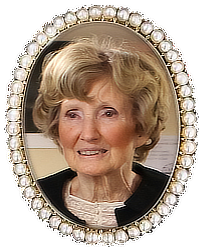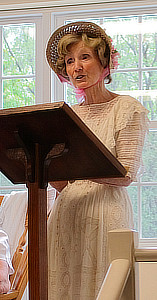
Whittier Cameo
Evelina Bray Downey
Evelina Bray Downey

|

|

|
 Played by Pat Thoen
Played by Pat Thoen
 Once he tried to visit me in at my home Marblehead. I could not receive him at the house, because my
parents forbade it, so I suggested a stroll; and we took a long walk along the seashore together. At the
time we thought we were in love with each other but there were too many obstacles to overcome. My
family was wealthy; he was a poor farmer without much of a future. He was a Quaker who disapproved
of music, where I played the piano and dearly loved music and art. We ended up going our separate
ways.
Years later, I was a teacher in St. Louis. There I married an Episcopal clergyman, Rev. William S. Downey.
I met my husband during an epidemic when our school had been turned into an emergency hospital and
he had been a patient there.
It was not an ideal marriage. To my friends I admitted that in unhappiness, loneliness, and desperation I
vowed to marry the first man who offered himself. What a mistake! My husband was overbearing and
tyrannical, and when he found out I had been a childhood friend of Whittier, he wrote John, taking
advantage of our old friendship by asking him for money, which John sent. I was furious when I found
out.
When John was working in Philadelphia, I was living there with my husband and he stopped by for a
visit. It was quite a surprise! We met again at an Academy reunion in 1885, where we renewed our
relationship. John was the center of attention, but we had a chance to exchange souvenirs and take
another seaside walk. It was about this time John wrote the poem called A Sea Dream, recalling the
seaside walk of our youth.
Although I didn't see him again, we corresponded often. His last letter to me was written a few weeks
before he died.
Whittier donated $10,000 to the Amesbury Home for Aged Women. A room at the home was called
"The Whittier Room" and was furnished with furniture from his house that was used when he
entertained his guests.
I applied for admission to the home two years after his death because I wished to live the sunset time of
my life near his memory and his grave. There are miniature portraits of both Greenleaf and me in the
Amesbury home. After John's death, I donated a piece of china to the birthplace in Haverhill that is still
on display.
Once he tried to visit me in at my home Marblehead. I could not receive him at the house, because my
parents forbade it, so I suggested a stroll; and we took a long walk along the seashore together. At the
time we thought we were in love with each other but there were too many obstacles to overcome. My
family was wealthy; he was a poor farmer without much of a future. He was a Quaker who disapproved
of music, where I played the piano and dearly loved music and art. We ended up going our separate
ways.
Years later, I was a teacher in St. Louis. There I married an Episcopal clergyman, Rev. William S. Downey.
I met my husband during an epidemic when our school had been turned into an emergency hospital and
he had been a patient there.
It was not an ideal marriage. To my friends I admitted that in unhappiness, loneliness, and desperation I
vowed to marry the first man who offered himself. What a mistake! My husband was overbearing and
tyrannical, and when he found out I had been a childhood friend of Whittier, he wrote John, taking
advantage of our old friendship by asking him for money, which John sent. I was furious when I found
out.
When John was working in Philadelphia, I was living there with my husband and he stopped by for a
visit. It was quite a surprise! We met again at an Academy reunion in 1885, where we renewed our
relationship. John was the center of attention, but we had a chance to exchange souvenirs and take
another seaside walk. It was about this time John wrote the poem called A Sea Dream, recalling the
seaside walk of our youth.
Although I didn't see him again, we corresponded often. His last letter to me was written a few weeks
before he died.
Whittier donated $10,000 to the Amesbury Home for Aged Women. A room at the home was called
"The Whittier Room" and was furnished with furniture from his house that was used when he
entertained his guests.
I applied for admission to the home two years after his death because I wished to live the sunset time of
my life near his memory and his grave. There are miniature portraits of both Greenleaf and me in the
Amesbury home. After John's death, I donated a piece of china to the birthplace in Haverhill that is still
on display.